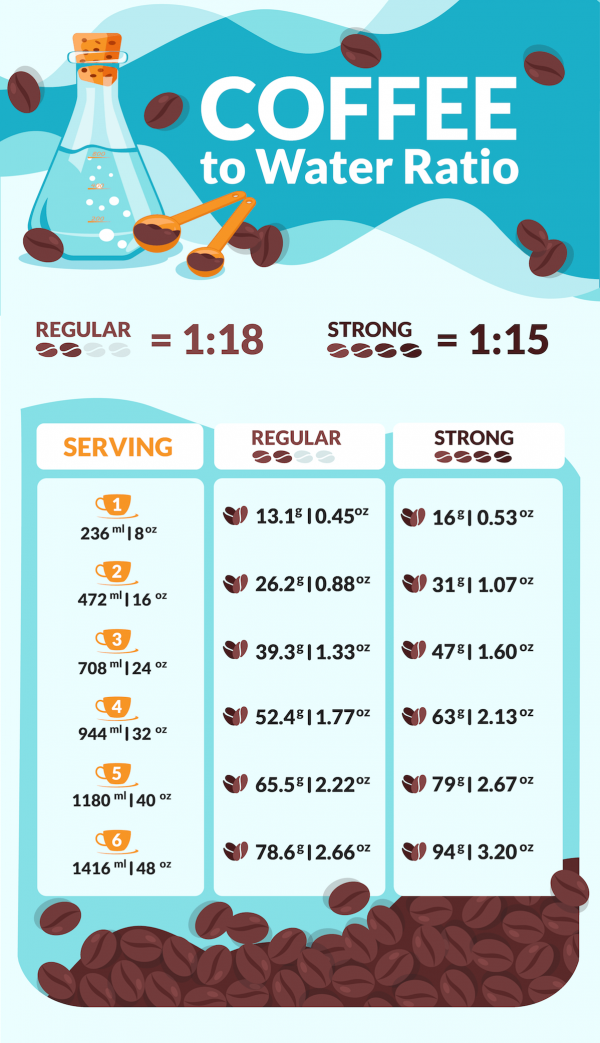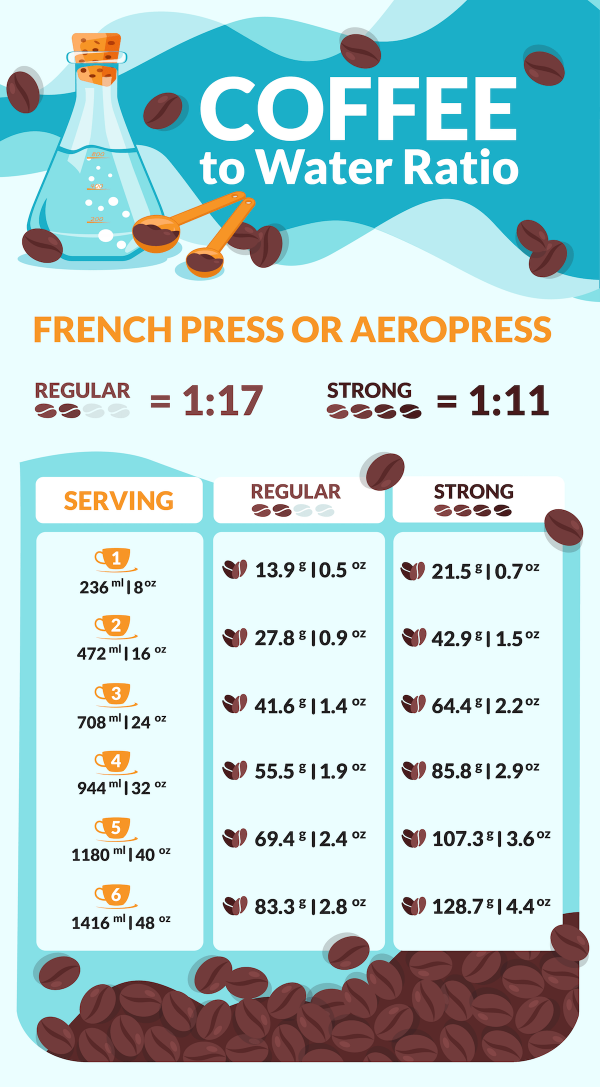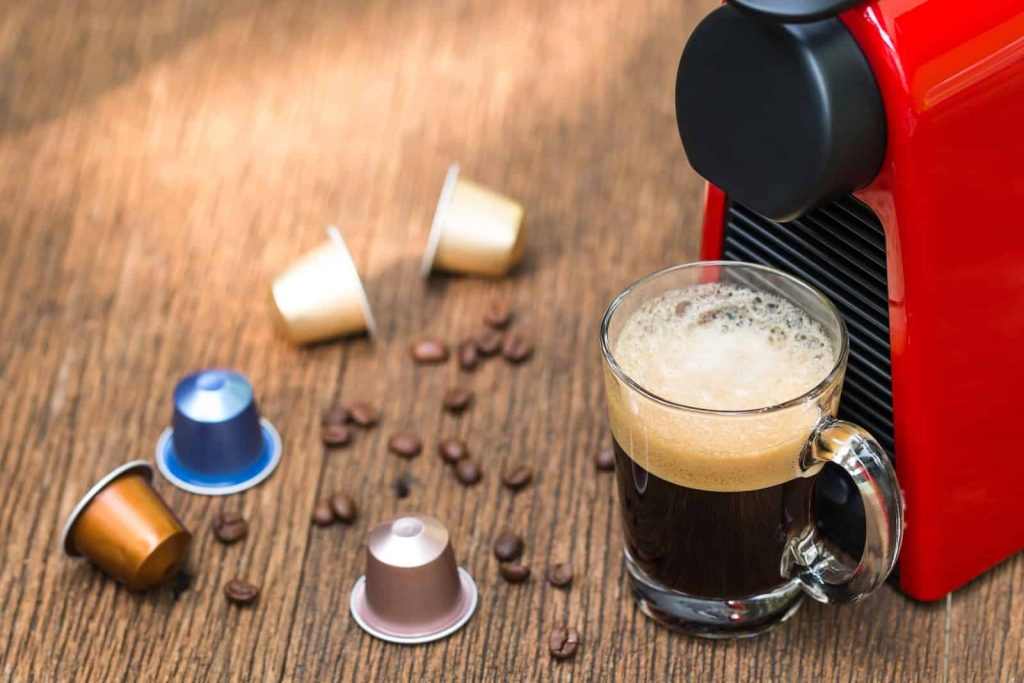To make good coffee requires some pretty good details, one of which is the ratio of coffee to water. Through this post, we will guide you to find the optimal ratio of coffee to water for brewing coffee by any method, drip coffee is no exception.
While there are many possible reasons why you might not get fresh, quality coffee in the morning, looking at your coffee to water ratio is one of the best places to start an inspection.
Contents
Reason to Use Brew Ratio
Why do coffee people talk more about ratios than recipes? That’s because the ratio is more practical, you can quickly increase and decrease it.
To be able to follow ratios easily you just need a proper digital scale, as ratios will work best when using grams or ounces. Because, the weight of the coffee beans is very relative, depending on the growing and roasting conditions.
Moreover, using the measuring spoon or observing the amount of water will be inaccurate in the long run.
What Is the Best Coffee Ratio to Water?
If in the title of the article we are talking about the ratio of drip coffee, it’s actually only part of the interesting discussion about the ratio of coffee to water.
Maybe you’ve heard of the Golden Ratio before, the ideal formula for making the perfect cup of coffee every time. If you think so, it’s actually a little too simple.
After all, there is no perfect ratio for any cup of coffee, every brewing method. The ratio of drip coffee is the same.
But, that doesn’t mean we can’t get the best ratio for brewing coffee. After quoting from several references, we have a formula with near perfect accuracy.
This are the following serving size table of coffee ratio to water based on several brewing methods:
General Coffee Brewing Ratio

As we know in various common brewing methods, the ratio of 1:18 will give a lighter and softer taste in the mouth. If you want strong, flavorful coffee then go for a 1:15 ratio.
We really encourage you to experiment, feel free to try different ratios side by side to get your preference.
What you should know in general is that you shouldn’t use a ratio that is stronger than 1:12. Since, that ratio will result in a coffee that’s too thick and muddy, this is true for most methods. Conversely, if you use a ratio lower than 1:20 it will make your coffee watery, tasteless or may be too bitter.
Pour Over or Drip Coffee Ratio

Drip coffee which is also known as the infusion brewing method is the most common type for many coffee drinkers. We know you may be waiting for this topic because you read the title.
You can get this method with an automatic drip machine or using a manual pour-over brewer such as Chemex.
The continuous supply of fresh water flowing through the coffee makes this method an efficient way to brew coffee. This process will help extract all of the TDS without over saturating the grounds.
Due to the efficiency of the drip coffee brewing method, it usually requires fewer coffee grounds. The drip coffee ratio is commonly between 1:15 for a bold taste and 1:17 for the standard.
Immersion Style

The methods like French Press and AeroPress belong to use this brewing style.
The coffee ground that immersed in the water entire the time will be saturated. Therefore, the extraction isn’t as efficient as the drip coffee brewing method. Since the same water is in contact with the coffee ground in a long enough time.
To counter the saturating issue, you can agitate the grounds, or use more coffee ground to ensure you get more flavor.
These immersion methods are typically used coffee to water ratio start from 1:15 for a standard brew and go as low as 1:12 for a strong brew.
Cold Brew

If you think the cold brew method also includes an immersed style, that’s right.
However, there is a slight difference from the standard method because the water in the cold brew method is not heated. Therefore, it is necessary to adjust the ratio to prevent this failure. If you use a standard brew ratio instead of a cold brew ratio, you’ll only get brown water, not coffee.
The cold brew method requires a lot of coffee ground because the process is much more volatile and takes longer. This means that the possibility of the ground becoming saturated is also greater.
For a strong, flavorful cold brew coffee, you can usually use coffee to water ratio of 1: 5. Otherwise, if you want a lighter drink, just go for 1: 18.
Special Mention: Espresso

Although espresso is technically an infused brew, it is very different from drip coffee. Espresso brewing is a very different from other coffees, apart from involving pressure in the brewing process it has a fewer volume with a stronger, bolder taste.
Due to the versatility of the espresso drink, it is quite difficult to really determine the perfect ratio. In general, to get a ristreto shot, baristas use a 1: 1 ratio, the ratio for normal espresso is 1: 2-3 and 1: 4 for lungo shots. This ratio also changes because brewing espresso is also influenced by the consistent grind quality.
Effect of Coffee Ratio When Brewing Coffee
Brewing drip coffee or even any other method is a relatively simple process. Because basically, brewing coffee is a process of extracting ground coffee using hot water.
Because of that simplicity, the drip coffee ratio to water has a significant influence on the extraction process and the strength of the coffee you get.
Extraction
Extraction is process of pulling the soluble compounds (like caffeine, carbohydrates, lipids, acids, and sugars) out of the coffee, which gives it the flavor we all love.
Apart from brew time, brew ratio also affect the extraction. If too much coffee, and you’ll get an under-extracted drink that is often sour without much sweetness. Too much water, your coffee will be over-extracted, which isn’t good either because it will pulling more acidic, bitter flavors out.
Strength
The first thing you need to know is, strength refers to the flavor of the coffee, not the caffeine content. Flavor of coffee is largely determined by the amount of Total Dissolved Solids (TDS).
If you want a stronger cup, with a bold taste, you’ll need more coffee to allow for more TDS in the cup without over-extraction.
If you don’t have enough coffee, you will end up with thin, watery coffee. Conversely, if it’s too much, it will muddy your coffee.
Brew Ratio Basics
Because the only ingredients used are coffee and water, many people mix coffee and water without measuring the measurements first.
The result, the inconsistency they get, one day the coffee is good but not the next day.
The coffee to water ratio comes into play to help you experiment with several variables that you can fully control. Save you from opportunities for inconsistent coffee taste.
Professional Baristas Use Recipes
Professional baristas pay close attention to the consistency of the coffee they brew, meaning they have a recipe too. Because there are only two ingredients, so they pay close attention to it.
They can adjust the cup size of the coffee by adding more water. But that means they also need to adapt another ingredient which is coffee powder. This is called the ratio.
Why Use Weight for Your Brew Ratio
Although a spoon is the most common way to measure coffee. But this method cannot be relied on forever. The weight of coffee grounds in a spoon can vary from person to person, never accurate.
If you want to measure weight accurately, of course you have to weigh it. This is the reason why the scale in the ratio uses units of weight.
In this case we are lucky because the volume unit of water can be converted into a unit of weight easily. Every one milliliter of water weighs one gram, that also means half a liter weighs 500 g. So simple.
What the Ratio Numbers Mean
Ratios are usually expressed as numbers, such as 1:12 and 1:16. This means “every 1 gram of coffee is ideally brewed with 12 grams of water” and “every 1 gram of coffee is ideally brewed with 16 grams of water”.
Then what if you want to brew 1 liter of water with a ratio of 1:16? You need to divide 1 liter (1000g) by 16. The result is 62.5 g of ground coffee you should use.
The Conclusion
Quality coffee should be on a short list of what we can truly control in your life. You don’t need much effort to control the brewing process to get the consistency of the taste of your coffee.
Making the coffee to water ratio a reference whenever you brew coffee is a very simple way. Using only a few measurements and calculations you will always get the consistency of taste in your daily drink.
Through ratio, you can also do a little experimentation to find your personal preferences. Of course you also have to pay attention to the type of coffee and brewing method in using this ratio.
Read also:

This is a very good article, and I assume that since your focus was ratios is the reason you left out three other important variables, grind size and roast type, and perhaps most important – water temperature.
My daily brew is with my French Press, but for large gatherings I use my electric drip. Since it doesn’t get the water hot enough, I preheat the water and pour it into the dispenser. I also save a little to bloom the coffee prior to turning on the pot which then dispenses properly heated water. Then I move the coffee to an insulated container rather than leave it on the hotplate.
As I said, I enjoyed your article and will pass it along. I am a home roaster and continue to read and experiment with coffee. It’s amazing the delightful variations you can get out of just two base ingredients and a bit of heat.
Blessings……….biff
Thank you for the incredibly thorough overview! I believe this is the absolute best write-up I’ve seen on the ‘ratio’ topic. Cheers! ☕
Why are you mixing the imperial(oz) with the metric(grams)? This makes no sense at all like this. Imperial is already not very universal, but you could at least stick to one.